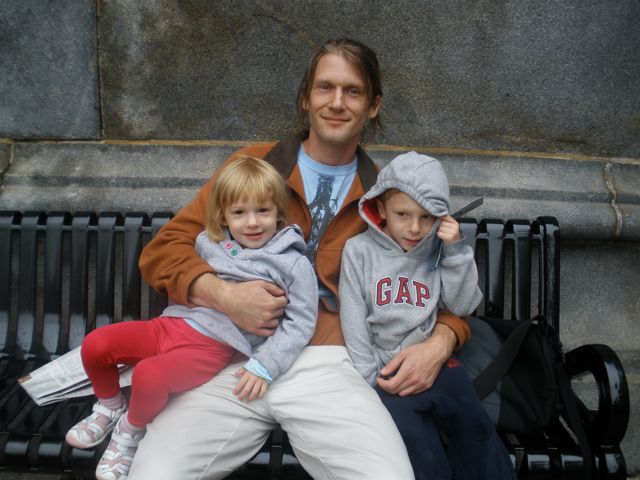I take both kids grocery shopping pretty much every weekend, and I have since each was an infant. It’s a routine for us in which Mommy gets some quiet time around the house and I get some extended time around town with my little ones.
This time of year, the excursion includes the farmer’s market. (Which, by the way, if you are ever in St Paul on a Saturday morning, you must attend; it’s one of the best in the country for sure.)
There is a tremendous amount of construction in the area right now, so the walk from where we park is circuitous and requires sharing a short stretch of street with an occasional slow-moving automobile.
Me: Can you guys grab my hands please? A car is coming.
Tabitha (five years old): We each get a hand!
Me: Yeah. Good thing I only have two kids, huh?
T: Yeah, if there were more kids, there wouldn’t be enough hands. Like Yusef [our next-door neighbor who has three children].
Me: Oh, right. Good point. What if Natalie came too, though?
T: Then there would be an extra hand to carry a bag. You don’t have that.
Me: Right. Sorry. That means you’re going to get hit by the bag a few times. At least it’s not full yet, though.
[pause]
Me: Do we know anyone with fewer children than hands?
T: Dawn!
Me: Good. I hadn’t gotten to her yet. I was thinking about Jenn, but she has Wynne and Emmett; and I was thinking about Addie, but she has August and Leo. Then I thought about Jimmy, but he has Leila and Otis. I hadn’t thought about Dawn yet. She just has Mateo, doesn’t she?
T: Yeah. So she would have an extra hand for a bag.
So What Do We Learn?
An important thing to notice here is that there is only one number word in this whole conversation. I say the word two. That’s it.
The rest is about whether Set A (children) has more or fewer members than Set B (parental hands available for holding). This is a remarkably sophisticated idea. The fancy math term for what we are talking about here is one-to-one correspondence. It refers to the fact that when two collections (A and B) have the same number of things, we can match them up; one thing from set A and one from B, with no leftovers in either collection.
The mind-blowing part of one-to-one correspondence is that it’s true the other way around. If we can match up with no leftovers, then the sets are the same size. Even if we don’t know how big either set is. That is what this conversation works with—comparing sizes of sets without stating the size of either one.
I am quite certain that Tabitha pictured Yusef holding the hands of two children, leaving one who held Natalie’s hand. That left one hand unheld, available for a bag. I do not think (although it’s possible) that she thought 4 hands minus 3 children leaves one.
She matched kids to hands in her mind. One-to-one correspondence.
Starting the Conversation
Listen, and notice when your child is comparing two quantities. maybe they are equal (as in this case), maybe they are not.
As in this conversation, you don’t need to discuss actual numbers to compare two quantities. More, fewer, same…there are many times your children use these words. Follow up with some what if questions and see where they lead.
Beyond the Conversation
One-to-one correspondence, and its implication that we can compare two sets without counting either one, was the idea that Georg Cantor exploited in the late 1800’s to prove that some infinities are “bigger” than others. Cantor demonstrated that there are just as many whole numbers as fractions (because we can cleverly match them up in one-to-one correspondence), but more real numbers than fractions (because it is impossible to match them up in one-to-one correspondence; any attempt you might make will leave out some real numbers).
Five year olds do not need to know this. Nor do you, probably. Middle school kids will find it fascinating. Cantor’s argument is accessible to most high schoolers (but would never occur to them, nor to me—it’s a brilliant insight).
Marilyn vos Savant is wrong when she writes, “Math doesn’t enlighten us the way literature, social studies, or art appreciation do.”

